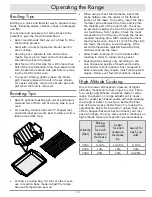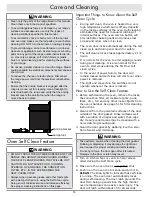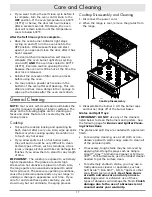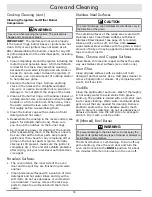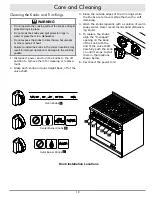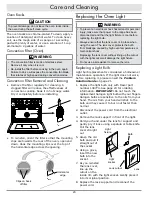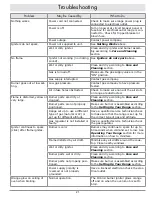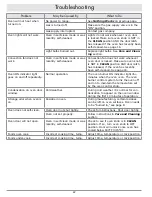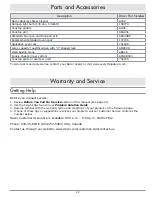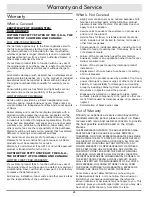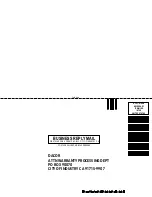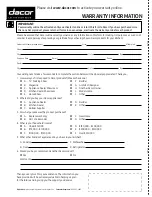
16
Care and Cleaning
WARNING
• Clean only the parts of the range listed in this manual.
Clean them only in the manner specified.
• To avoid dangerous fumes or damage to your range’s
surfaces and accessories, use only the types of
cleaning solutions specified in this manual.
• To avoid electric shock or burns, turn off the burners
and oven and make sure that all parts are cool before
cleaning. DO NOT turn the burners on during cleaning.
• To prevent damage, do not use abrasive or corrosive
cleaners or applicators such as steel wool or scouring
pads on any part of the range unless instructed to do
so. Use only a sponge, soft cloth, fibrous or plastic
brush or nylon cleaning pad for cleaning the surfaces
of your range.
• Do not use a steam cleaner to clean the range. Steam
could penetrate the electrical components and cause a
short circuit.
• To reduce the chance of electric shock. Disconnect
the range power cord from the electrical outlet before
cleaning.
• Ensure that the anti-tip bracket is engaged after the
range is moved out for cleaning. Use a flashlight to
look underneath the range and verify that the anti-tip
bracket covers the anti-tip foot when the range is
moved back into place.
Oven Self Clean Feature
WARNING
• DO NOT TOUCH THE OUTSIDE SURFACES OF THE
RANGE, INCLUDING THE BACKGUARD, DURING
THE SELF CLEAN PROCESS. THEY WILL BE HOT.
• CAUTION: DO NOT LEAVE FOOD, COOKING
UTENSILS, OVEN RACKS, THE CONVECTION
FILTER, ETC., IN THE OVEN DURING THE
SELF-CLEAN CYCLE.
• Always wipe up excess grease and other food spills
with a damp cloth prior to using the Self Clean cycle.
Doing so will minimize smoke and increase efficiency.
See proper cleaning instructions on this page.
Anti-tip foot
Anti-tip bracket
Important Things to Know About the Self
Clean Cycle
• During self clean, the oven is heated to a very
high temperature which burns off any deposits
on the inside surfaces of the oven. Self-cleaning
eliminates the need for manual scrubbing of
interior surfaces. The oven will run better, will
provide better baked goods and produce less
smoke and odors when it is clean.
• The oven door locks automatically during the self
clean cycle and during cool down for safety.
• The self clean process takes approximately 2 1/2
hours.
• It is normal for the oven to emit popping sounds
during self-cleaning. It is also normal for the
oven to emit smoke during the first few self
clean cycles.
• In the event of power failure, the door will
remain locked and self clean will start over when
power is restored.
• The light and convection fan switches do not
operate whenever the door is locked.
How to Use the Self Clean Feature
1. Before self-cleaning the oven, remove the racks,
the convection filter, all cookware (pots, pans,
forks, etc.), foil and any other loose objects from
the oven chamber. See page 51 for filter cleaning
instructions.
2. Clean soil from the porcelain surfaces of the door
outside of the door gasket. Rinse surfaces well
with a solution of vinegar and water, then wipe
dry. Heavily soiled areas may be cleaned with a
non-scratching scouring pad.
3. Clean the door gasket by dabbing it with a solu-
tion of water and mild soap.
WARNING
• Take extreme caution when cleaning the door gasket.
Rubbing or displacing it may damage the tight door
seal required for proper cooking and self-cleaning.
• Do not try to force the door open after it is locked.
Damage to the door or latch may result.
4. Turn on kitchen fans or vents to help remove
odors during the Self Clean cycle.
5. Make sure the oven door is completely shut.
6. Push in on the oven control knob and turn it to
CLEAN
. The knob lights to indicate that self clean
is running. The oven door automatically locks
during self-cleaning. The door latch prevents the
door from being opened since the high interior
oven temperatures can easily cause injury. The
door will latch within about 15 to 20 seconds.














